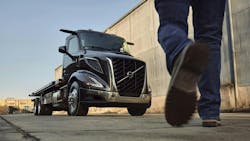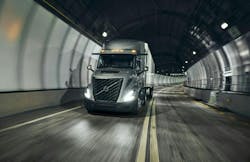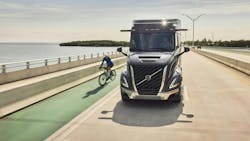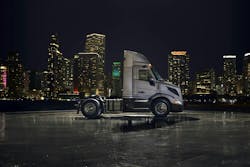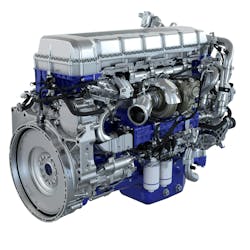In this article, you'll learn about:
- The new Volvo VNR, which is available in tractor and truck configurations
- The differences between the new VNR and the VNL
- The VNR's safety, fuel-efficiency, and driver productivity features
- The new Volvo D13 VGT engine powering the VNR
A year after the North American truck maker reimagined its flagship long-haul tractor, Volvo Trucks refreshed its regional Class 8 truck to meet the growing demands of urban delivery, bulk, and flatbed haulers.
New Volvo VNR specs
Engine: Next-generation Volvo D13 VGT
Power: 405-455 hp
Torque: 1,450-1,850 lb.-ft.
Truck class: Class 8
Vehicle applications: Urban, regional, bulk, flatbed, overnight, delivery
The all-new Volvo VNR was unveiled in Nashville on Monday night during a Volvo Trucks North America event at American Trucking Associations’ Technology & Maintenance Council exhibition. With a tighter turning radius, the new VNR is built for shorter-range operations, such as urban delivery. It also features improved aerodynamics and can be spec’d in sleeper configurations for longer hauls.
The new VNR shares a common platform with Volvo’s flagship VNL, which began serial production in 2024. “Both of the trucks have been built from essentially 90% new here in the U.S.,” Bobby Compton, VTNA product marketing manager for regional haul, told Fleet Maintenance affiliate FleetOwner before VNR’s public debut.
New Volvo VNR tractor and truck configurations
The new Volvo VNR is available as a tractor or straight truck in day cab and sleeper cab configuration based on cab model, trim level, and more. Volvo Trucks North America is making the new Class 8 available in 4x2, 6x2, and 6x4 tractors and multiple straight truck body types.
VNR 300: Top choice for day cab regional haul and urban delivery operations. VTNA said the 300 model offers the best turning radius and maneuverability in the Class 8 market.
VNR 440: Compact, mid-roof 42-in. sleeper cab with high maneuverability and room to rest.
VNR 640: Mid-roof 62-in. sleeper designed for weight-sensitive bulk haul or flatbed deliveries.
VNR 660: A premium, more spacious 62-in. high-roof sleeper that can be used for regional or long-haul trips. VTNA said this model combines aerodynamics for highway efficiency with the tight turning radius of other VNR configurations. This model could help fleets working with more stringent length restrictions.
VNR straight truck: All VNR models—300, 440, 640, and 660—are available as customizable straight trucks for various applications, such as box vans, flatbeds, rollbacks, expeditors, or tankers.
He said that VTNA spent countless hours working with dealers, visiting truck stops, and digging into current regional customers’ operations to develop the new VNR. Compton said Volvo Trucks implements safety and efficiency technologies developed in Sweden along with U.S. engineering improvements.
“We utilize the common platform and technologies and adapt and enhance it for the U.S. market,” Johan Agebrand, VTNA product marketing director said. “A lot from the VNL goes into the VNR, but the VNR has little differences.”
Some of those differences include better visibility for surface roads and cities and shorter wheelbases. “We’ve taken everything we had on the VNL and tried to improve it a little bit for that regional haul segment. That’s really what this truck is about.”
Along with updating the truck with technologies and amenities to benefit drivers who hop in and out of the VNR cab multiple times daily to complete deliveries, the new VNR focuses on regional wet and dry bulk carriers and flatbed operations.
“This truck is mostly catered to customers that would run 600 miles or less per day,” Agebrand said.
Volvo VNR trim packages
The all-new Volvo VNR series features steel construction and customizable exterior and interior design options. It is available in two trim levels: Core and Edge.
Core: Volvo describes this trim as “practical” and “ideal” for fleets with multiple drivers or applications that require frequent cab entry and exit. The interior door panels, kick panels, and dash are made of easy-to-clean polymers that hide wear and tear. Exterior trim pieces susceptible to high-traffic impacts can be repaired and replaced without painting.
Edge: Volvo described this trim level as featuring “bold styling” with chrome accents around the grille and air intake and a chrome-plated metal bumper. Other upgrades with Edge trim include a leather-wrapped steering wheel, soft-touch dash, and armrests.
Compton said most VNR customers drive less than 600 miles daily, but some spend a night or two on the road. That's why the VNR is also available in three sleeper configurations, along with the VNR 300 day cab, which Volvo expects to be the top choice of return-to-base customers. The VNR is also available as a tractor or straight truck in compact, mid-, and high-roof sleeper configurations.
“A regional haul customer is so much more unique,” Compton said. “So we needed to tailor our truck to their needs. A long-haul driver typically doesn’t stop until they hit their eight-hour break. But a regional customer, in that first eight hours, will get in and out of that vehicle 10, 15 times. They will perform work between each time of getting in and out of the truck. So we had to give that rugged feel to the truck.”
Volvo debuted a 24-volt electrical architecture in last year’s new VNL. This technology is now incorporated in the new VNR, making it the second North American heavy-duty truck to feature this higher voltage.
The 24-volt architecture allows for faster diagnostics, minimizing battery and electrical failures, Agebrand said. It incorporates lighter components and more reliable, serviceable wiring harnesses, reducing wear and tear due to the lower amperage.
The 24-volt architecture also paves the way for future innovations, according to VTNA. The new VNR will be the platform for future powertrain technologies, including battery-electric and alternative internal combustion engines.
Safety features of the new Volvo VNR truck
Part of the VNR redesign adds more Volvo advanced safety, connectivity, maneuverability, and visibility features that the OEM said will make it ideal for fleets operating among pedestrians.
With the Volvo Active Safety Platform, drivers get advanced assistance and safety systems:
- Volvo Active Driver Assist: Forward collision warning, lane departure warning, adaptive cruise control, and automatic emergency braking
- Optional VADA Plus with Volvo Dynamic Steering: Lane-keep support, blind spot monitoring, radar detection of pedestrians and cyclists, turn warnings
- Camera Monitor System: The integrated HD camera and display system allows for smaller cab-mounted mirrors and improved driver visibility and movement thanks to an auto-pan feature and infrared technology for low-light operations
- E-Call emergency response system
- Available side-curtain airbags
- Advanced Tire Pressure Monitoring System
- Electronic parking brake offers auto-activate and auto-release functions
Volvo VNR fuel-efficiency features
Thanks to improved aerodynamics, powertrain innovations, and idle reduction technologies, the new VNR is 7.5% more fuel efficient than its predecessor.
Powertrain upgrades account for about 30% of that overall improvement. The new VNR features the next-generation Volvo D13 VGT (Variable Geometry Turbo) engine, which Volvo says is more efficient. The D13 also has two other low-NOx engine ratings.
Fleets can spec the D13 Turbo Compound engine, which uses a waste heat recovery system to capture lost energy and maximize efficiency. When paired with Volvo’s I-Torque package, this engine provides versatility for fuel efficiency and performance.
This is how Volvo engineers are also offering regional fleets fuel savings:
- Eco-roll technology: Driveline disengages on downhill grades to allow the truck to save energy
- Redesigned cab: The wedge-shaped body guides airflow to balance aerodynamics and cooling
- No exterior sun visor: Designed not to need an outside visor to optimize over-the-roof airflow
- Windshield: Aggressive windshield curvature reduces drag
- Customizable idle shutdown
- Optional Adaptive Loading: A 6x2 lift axle designed to optimize fuel efficiency by balancing the weight between axles when heavily loaded
- Electronic Controlled Suspension: ECS adds remote-control option to trailer hook and drop
- Global Rear Air Suspension: Allows driver to set different ride heights
Volvo VNR driver amenities and productivity
Volvo engineers redesigned the VNR to help drivers be more productive while driving to the next stop or when stopping to work. Engineers made controls easier to reach and use while moving optional navigation displays to eye level.
Some other driver focused features include:
- Short Stop parking heater: Available in day cab models, this keeps the cab warm up to 30 minutes without idling, reducing fuel consumption while drivers unload in the cold
- Sleepers: Available in 42-in. and 62-in. configurations, VTNA said the VNR sleeper cabs feature the industry’s largest mattress
- Dark: Overlapping curtains can block outside light and distractions
- Light: An adjustable interior lighting system minimizes overhead glare
- Storage: Upper bunk can convert into additional storage to go with the wardrobe unit
Service and connectivity
Volvo Trucks’ Blue Service Contract provides predictive maintenance, remote diagnostics, and access to a network of more than 400 Certified Uptime Dealerships, allowing fleet managers to coordinate service, software updates, recalls, and more.
The Volvo Connect portal and MyTruck App provide fleets with extensive truck data, remote access, and precise control over operations. In addition to providing live views of fluid levels and check-lamp statuses, fleets can analyze vehicle data and even remotely change parameters such as governed speed limits.
The new VNR will be built at the Volvo Trucks New River Valley Plant in Dublin, Virginia. Sales will begin later this year, but no firm date has been given.
Volvo's new turbo engine
Along with rolling out an all-new VNR, Volvo Trucks North America has a new turbo engine designed to power regional operations better.
The new Volvo D13 Variable Geometry Turbo Engine was unveiled with the new VNR during an event at the American Trucking Associations’ Technology & Maintenance Council exhibition on March 10.
The new Volvo D13 VGT engine will be standard in the new VNR and available in the Volvo VNL day cab launched in 2024. The D13 VGT engine builds on the improvements launched with the D13 Turbo Compound engine standard on the Volvo VNL.
Volvo D13 VGT engine specs
Fuel: Diesel
Power: 405-455 hp
Torque: 1,450-1,850 lb.-ft.
Displacement: 13 liters
Truck class: Class 8
Models: Volvo VNR, Volvo VNL day cab
While the turbo-compound engine is tailored for long-haul and highway cruising, the new VGT engine is made for the stop-and-start operations with regional hauls.
“If you have a lot of deliveries—you’re getting out of this vehicle 15 times a day—that vehicle may cool down a little bit while you’re doing it,” Johan Agebrand, VTNA product marketing director, said before the launch event. “The VGT, through its veins, can create resistance and get that heat back up quickly. It has certain benefits, like those, that really suit this kind of customer base.”
Agebrand said that VTNA is working to match its engine technologies to best suit its customers’ applications. The new D13 VGT would also be ideal for bulk haulers making several deliveries or refills daily.
New enhancements to Volvo D13 Variable Geometry Turbo engine
With a focus on fuel efficiency and durability, Volvo Trucks highlighted these enhancements to the D13 VGT engine:
- Advanced piston design: Improved seven-wave piston optimizes air and fuel mixture control, resulting in more efficient combustion. Piston height was decreased and paired with a longer connecting rod to minimize cylinder sidewall pressure, reduce friction, and enhance overall performance. The seven-wave design allows for a more heat dispersion across the top of the piston head, lowering the overall temperature and reducing NOx output.
- Enhanced fuel injector: Smaller needle control valves in the fuel injectors provide precise and rapid control over the fuel flow rate, leading to improved fuel atomization, better combustion efficiency, and enhanced engine performance.
- Variable displacement oil pump: Pump dynamically adapts to the engine's oil pressure demands, minimizing parasitic losses, reducing wear and tear, and improving efficiency.
"Fuel costs remain the second highest expense for fleets in North America and our powertrain improvements represent an up to 3% fuel efficiency improvement over our previous generation engine,” Peter Voorhoeve. VTNA president, said. “The D13 VGT engine is built to deliver the performance and reliability our customers expect while also contributing to a cleaner, more efficient future."
The new engine benefits from Volvo’s 24-volt electrical system, which debuted in the new VNL in 2024 and is part of 2025’s VNR. The 24-volt architecture allows the OEM to use lighter components at a lower amperage.
The Volvo D13 VGT engine is available for order in the new Volvo VNR and VNL models. Customers can choose from engine options offering 405, 425, 435, and 455 hp, with torque ratings ranging from 1,450 to 1,850 lb.-ft.
Customers purchasing the all-new Volvo VNR when orders begin will also have the option to select the D13 Turbo Compound engine, which is well suited for fleets using the VNR in a highway application.
This article was originally published on FleetOwner.com.
About the Author
Josh Fisher
Technology Editor
Editor-in-Chief Josh Fisher has been with FleetOwner since 2017. He covers everything from modern fleet management to operational efficiency, artificial intelligence, autonomous trucking, alternative fuels and powertrains, regulations, and emerging transportation technology. Based in Maryland, he writes the Lane Shift Ahead column about the changing North American transportation landscape.
